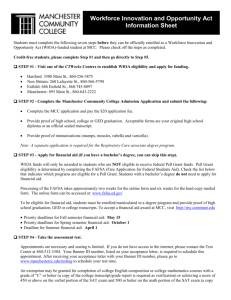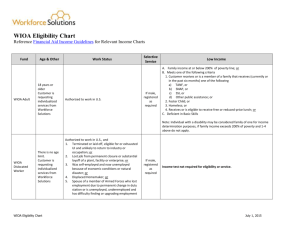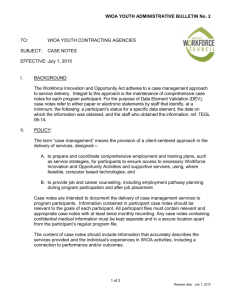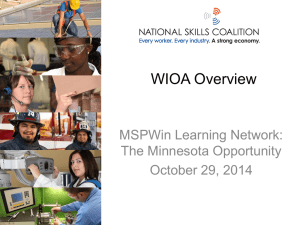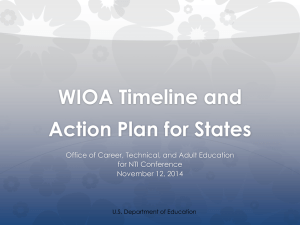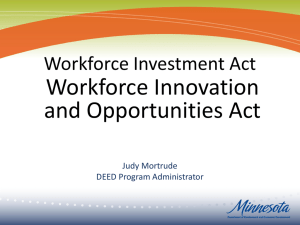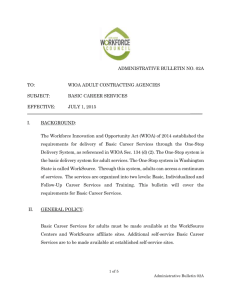Achieving Employment Outcomes
advertisement
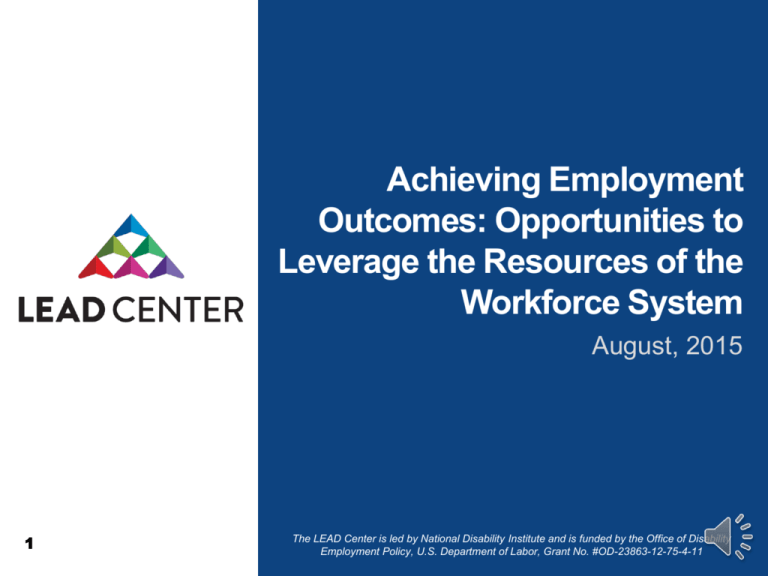
Achieving Employment Outcomes: Opportunities to Leverage the Resources of the Workforce System August, 2015 1 The LEAD Center is led by National Disability Institute and is funded by the Office of Disability Employment Policy, U.S. Department of Labor, Grant No. #OD-23863-12-75-4-11 TODAY’S PRESENTERS Rebecca Salon LEAD Center Project Director National Disability Institute rsalon@ndi-inc.org Elizabeth Jennings LEAD Center Assistant Project Director National Disability Institute ejennings@ndi-inc.org Serena Lowe Senior Policy Advisor Workforce Development Office of Disability Employment Policy U.S. Department of Labor Lowe.Serena.D@dol.gov 2 The National Center on Leadership for the Employment and Economic Advancement of People with Disabilities (LEAD) is a collaborative of disability, workforce and economic empowerment organizations led by National Disability Institute with funding from the U.S. Department of Labor’s Office of Disability Employment Policy, Grant No. #OD-23863-12-75-4-11. This document does not necessarily reflect the views or policies of the U.S. Department of Labor’s Office of Disability Employment Policy, nor does the mention of trade names, commercial products, or organizations imply endorsement by the U.S. Government. 3 LEAD CENTER MISSION To advance sustainable individual and systems level change that results in improved, competitive integrated employment and economic self-sufficiency outcomes for individuals across the spectrum of disability. www.leadcenter.org 4 OBJECTIVES Participants will learn about: The opportunities created by the Workforce Innovation and Opportunity Act (WIOA) to support employment and economic advancement outcomes for people with disabilities Partnership and collaboration opportunities Opportunities for people with disabilities, providers and advocates to become involved in the implementation of WIOA Useful resources 5 STRUCTURE OF THE WORKFORCE INVESTMENT SYSTEM State Workforce Investment Agency 6 Local Workforce Boards American Job Centers FORMULA & DISCRETIONARY GRANTS H-1B Technical Skills Training Grants Formula Grants Discretionary Grants Adult Youth Dislocate d Worker 7 TACCT (Trade Adjustment Assistance Community College and Career Training Grant Program) ARRA Grants (LMI; Health & HGI; State Energy Sector Partnerships; Energy Training Partnerships; Green Capacity Building Grants WHAT ARE AMERICAN JOB CENTERS (AJCS)? AJCs, formerly called One-Stop Career Centers, are designed to provide a full range of assistance to job seekers under one roof. AJCs provide training, referrals, career counseling, job listings, and similar employment-related services. A job seeker can visit a center in person or connect to the center's information remotely through a computer. Services are free. Staff are available to help people look for work, find training, and answer employment-related questions. AJCs have computers, printers, phones and fax machines available that people can use in their job search. 8 WHAT SERVICES ARE AVAILABLE FROM AN AJC? Services vary by location but can include: Resource rooms with phones, free internet and resume writing tools Employment plan development Job training services Job search assistance Career counseling Practice interviewing Skills testing Labor market and employer information Employment Workshops 9 INTRODUCTION WIOA signed into law on July 22, 2014 (PL)113-128 Proposed rules to implement WIOA were released in Spring 2015 Job seekers with and without disabilities may receive and benefit from job search and placement assistance, career counseling, skills training, and other supportive services. The new law took effect July 1, 2015 except for amendments to the Rehabilitation Act which took effect on the date of enactment 10 FROM A DISABILITY PERSPECTIVE WHAT ARE THE BIG CHANGES? Emphasis on career pathways and sector partnerships to promote employment in indemand industries and occupations Eliminates sequence of services before enrollment in training Establishes a single Unified State Strategic Plan 11 FROM A DISABILITY PERSPECTIVE WHAT ARE OTHER THE BIG CHANGES? Individuals with disabilities must be a part of State and Local Strategic Plans Performance outcomes must be identified and reported (including by disability) Criteria for certifying American Job Centers must include assessing physical and programmatic accessibility of facilities, programs, services, technology and materials, and appropriate staff training and support 12 WHAT ARE BIG CHANGES REGARDING YOUTH? 75% of the youth formula program funds must be spent on out of school youth as compared to 30% under WIA (Title I) At least 20% of local youth formula funds must be used for work experiences such as summer jobs, on the job training and internships (Title I) At least 15% of state VR funds must provide pre-employment transition services to prepare youth for post-secondary education and employment (Title IV) 13 ADDITIONAL SYSTEM COORDINATION REQUIREMENTS (TITLE I) Align employment, training, and education including career and technical education with human services programs not covered by the unified state plan Describe how community colleges will be engaged as partners in the workforce development system Promote work-based training and sector strategies to address the needs of multiple employers in the industry 14 ADDITIONAL SYSTEM COORDINATION REQUIREMENTS (TITLE IV) VR must enter into formal agreements with state Medicaid, I/DD, and Mental Health agencies to improve coordination of resources VR must improve and expand VR services for students with disabilities on a statewide basis. VR in the state plan must indicate how services will be coordinated with the Ticket to Work program VR must improve engagement with in-demand industry sectors to increase competitive integrated employment opportunities 15 FOR THE FIRST TIME Adds definition of customized employment in Title IV Promotes financial literacy activities for youth and adults with disabilities (Title I) Extends length of time for supported employment services from 18 to 24 months (Title IV) Places new limitations on use of subminimum wage (Title IV) Creates a Federal Cross-Agency Advisory Committee on Increasing Competitive Integrated Employment for Individuals with Disabilities (Title IV) 16 WIOA FOCUS ON CUSTOMIZED EMPLOYMENT Adds definition of customized employment in Title IV Competitive integrated employment Based on individual determination of strengths, needs, and interests of the individual with a significant disability Designed to meet specific needs of the individual and employer Carried out through flexible strategies 17 WHAT IS CUSTOMIZED EMPLOYMENT? Customized employment is a flexible process designed to personalize the employment relationship between a job candidate and an employer in a way that meets the needs of both. It is based on an individualized match between the strengths, conditions, and interests of a job candidate and the identified business needs of an employer. Customized Employment utilizes an individualized approach to employment planning and job development — one person at a time . . . one employer at a time. 18 WHAT MIGHT CUSTOMIZED EMPLOYMENT LOOK LIKE IN THE WORKPLACE? Customized employment might involve: Task reassignment, with some of the job tasks of a worker reassigned to a new employee. This reassignment allows the incumbent worker to focus on the critical functions of his/her job (i.e., primary job responsibilities) and complete more of the central work of the job. Task reassignment typically takes the form of job creation, whereby a new job description is negotiated based on current, unmet workplace needs. Job carving: An existing job description is modified, containing one or more, but not all, of the tasks from the original job description. Job sharing: Two or more people share the tasks and responsibilities of a job based on each other's strengths. 19 ALIGNMENT OF HCBS & WIOA AROUND CUSTOMIZED EMPLOYMENT WIOA Establishes customized employment as a service under VR Workforce investment system available to provide discovery (individual/group), skills building and career pathway development HCBS Allows HCBS waivers and state plan options to pay for customized employment strategies. Guidance around pay-for-performance expected that includes customized employment as a potential outcome payment 20 WIOA FOCUS ON FINANCIAL EDUCATION IN YOUTH PROGRAMS WIOA ensures youth with disabilities will receive extensive pre-employment transition services so they can successfully obtain competitive integrated employment. Supports disconnected youth, of which youth with disabilities comprise a high percent, by: Requiring local areas to increase percentage of youth formula funds used to serve out-of-school youth to 75% (30% under WIA). Requiring local areas to spend at lest 20% of youth formula funds on work experience activities. Providing additional allowable activities including financial literacy education and entrepreneurial training. 21 21 WHAT MIGHT FINANCIAL LITERACY ACTIVITIES LOOK LIKE? Place financial education curriculums on resource room computers and have it be a requirement in between benchmarks or meetings. Incorporate financial education within Job Clubs or as part of the Job Readiness workshops offered. Incorporate Financial Education Resources into TANF and SNAP Programs. Menu planning and shopping list tools Coupon workshop and handouts 22 ALIGNMENT OF HCBS RULE RE: PERSONAL RESOURCES & WIOA FOCUS ON FINANCIAL EDUCATION WIOA provides guidance on the use of state funds to provide services that build customer’s financial education and financial capability. As a program element for youth and allowable service for adults to support financial literacy, including an individual’s ability to: create household budgets, initiate savings plans, and make informed financial decisions about education, retirement, home ownership, wealth building, or other savings goals; manage spending, credit, and debt, including credit card debt, effectively; understand the availability and significance of credit reports and credit scores in obtaining credit, including determining their accuracy (and how to correct inaccuracies in the reports and scores), and their effect on credit terms; and understand, evaluate, and compare financial products, services, and opportunities Supports activities that address the particular financial literacy needs of non-English speakers. 23 VISION FOR THE WORKFORCE SYSTEM AND INITIAL IMPLEMENTATION OF WIOA (ETA TEGL 19-14) Issued February 19, 2015 Lays out the vision for a revitalized transformed workforce system as a result of implementation of WIOA Encourages workforce system leaders and partners to take action now to fully realize the vision of WIOA Provides an overview of upcoming guidance and technical assistance to support effective implementation Download TEGL 19-14: http://wdr.doleta.gov/directives/corr_doc.cfm?DOCN= 7353 24 SECTION 188 DISABILITY REFERENCE GUIDE On July 6, 2015, Secretary of Labor Tom Perez released TEN 01-15 “Promising Practices in Achieving Universal Access and Equal Opportunity: A Section 188 Disability Reference Guide” http://wdr.doleta.gov/directives/attach/TEN/TEN_0115_Acc.pdf The Reference Guide was jointly developed by: Civil Rights Center (CRC) Employment and Training Administration (ETA) Office of Disability Employment Policy (ODEP) With support and assistance from ODEP’s LEAD Technical Assistance Center at National Disability Institute. 25 SPECIFICS RE: SECTION 188 DISABILITY REFERENCE GUIDE Part I: contains continuum of examples highlighting some ways AJCs can meet their legal obligation broken out into sections on (1) universal access, (2) equal opportunity and (3) governance/Implementation. Part II: contains language from current Section 188 regulations that form the basis of the promising practices and includes hyperlinks directly to the promising practices in Part I. 26 EQUAL OPPORTUNITY AJCs are required to ensure that individuals with disabilities have equal opportunity to access their programs, benefits, and activities. Equal opportunity includes: Nondiscrimination prohibitions; Provision of reasonable accommodation; Provision of reasonable modifications; Administration of programs in the most integrated setting appropriate; Effective communication; Architectural and information and communication technology accessibility; and Prohibition of discrimination in employment context. 13 27 EQUAL OPPORTUNITY EXAMPLES OF PROMISING PRACTICES Nondiscrimination prohibitions— AJC rejects all job offers from employers that will not accept applications from individuals with disabilities. AJC selects sites for centers that are accessible. AJC regularly reviews eligibility criteria for training and other services to eliminate discriminatory criteria. 28 EQUAL OPPORTUNITY EXAMPLES OF PROMISING PRACTICES Provision of reasonable accommodation and reasonable modifications— AJC has a written reasonable accommodation/reasonable modifications policy in place posted on accessible website and included in written outreach materials and manuals, guidelines. 29 EQUAL OPPORTUNITY EXAMPLES OF PROMISING PRACTICES Administration of programs in the most integrated setting appropriate— AJC staff does not automatically refer all job seekers with disabilities State VR agencies but makes case by case determinations. ACJ staff provide services that lead to competitive, integrated employment. 30 EQUAL OPPORTUNITY EXAMPLES OF PROMISING PRACTICES Effective communication— Through accessible information and communication technology; Individuals who are deaf and hard of hearing; Individuals who are blind and visually-impaired; Individuals with intellectual and developmental disabilities; Individuals with mobility impairments; and Individuals with speech impairments. 31 EQUAL OPPORTUNITY EXAMPLES OF PROMISING PRACTICES Architectural and information and communication technology accessibility Equal Opportunity Officers are involved from the beginning of any physical site planning and technology acquisitions. The AJC makes technology accessible. AJCs may use lessons learned, the standards applied, and the technical resources regarding Section 508 of the Rehabilitation Act (applicable to federal agencies). 32 WIOA IMPLEMENTATION DATES January 22, 2016: DOL, ED and HHS must publish Final Rules to implement WIOA (18 months after enactment) Full list of WIOA Implementation dates: www.doleta.gov/wioa/pdf/WIOA-KeyImplementation- Dates.pdf 33 Strategies for Leveraging the WIOA and HCBS Opportunities to Improve Employment Options for PWD COLLECTIVE ACTION 34 EMPLOYMENT FIRST STATE LEADERSHIP MENTORING PROGRAM: UNIQUE FEATURES ODEP requires a minimum of six state agencies receiving Federal funds to be involved in EFSLMP state teams Education, I/DD Services, Medicaid, Mental Health, VR, and Workforce Investment Innovation in Virtual & Onsite Technical Assistance Cross disability in focus EFSLMP VISION QUEST ON WIOA IMPLEMENTATION: PARTICIPATING STATES 36 EFSLMP VISION QUEST ON WIOA IMPLEMENTATION: PROPOSED THEMES/SUBTOPICS Formal agreement/linkages between disability and workforce development systems for both adults and youth Enhanced enforcement of Section 188 (WIOA nondiscrimination requirements) Development of unified state plans Aligning policies of disability systems (VR, ID/DD, MH) with WIOA Development of VR cooperative agreement with ID/DD agency, Medicaid agency, others 37 Transition Components Development of systematic approach to new VR transition requirements, including MOUs/cooperative agreements with state Department of Education Implementation/enforcement of Section 511 (sub-minimum wage requirements) Employer Engagement Performance measurement: new common measures, disability as part of workforce development measures VISION QUEST ON WIOA IMPLEMENTATION: PROJECTED POLICY RESULTS – FY2015 (1) Interagency Cooperative Agreement on Resource Sharing/Service Coordination for CIE (Hawaii/NC/PA) Resource Mapping on Effective Practices/Braiding/Service Coordination Employment First/WIOA Executive Order (PA) Creating a policy and corresponding training program for workforce investment personnel (TN) Partnerships between workforce investment system and other systems to develop more T2W Employment Networks (TN; IA) 38 VISION QUEST ON WIOA IMPLEMENTATION: PROJECTED POLICY RESULTS – FY2015 (2) Personnel Development on Group Discovery/CE Coordination (TN; IA) Leveraging of Dislocated Adult Worker $$ to support transitions in sheltered workshop closures Bridging VR/Workforce Investment/IDD resources on pilot internship program for youth with significant disabilities (Utah) Establishing Out-of-School Youth Engagement Technical Guidance to Field (TN) Joint Policy Guidance re: implementation of key elements of WIOA related to transition of youth/young adults with disabilities (Michigan; Ohio) 39 COLLECTIVE ACTION: ACTIONS YOU CAN CONSIDER & PROMOTE 1. Become informed and involved in WIOA implementation. 2. Become an active stakeholder in the advisory committee on increasing competitive integrated employment for individuals with disabilities (http://www.dol.gov/odep/topics/WIOA.htm). 3. Improve effective and meaningful participation of job seekers with disabilities in American Job Centers (AJCs). 4. Help inform criteria for certifying AJCs or “One-Stop Career Centers”. 40 COLLECTIVE ACTION: MORE ACTIONS YOU CAN CONSIDER 5. Promote customized employment, individual supported employment, and financial literacy activities for youth and adults. 6. Become involved in the Unified State Plan development in your state. 7. Improve coordination of Pre-employment Transition Services for Youth. 8. Engage in the development of an interagency agreement between your state’s VR, workforce investment, education, I/DD adult services, and mental health systems to implement both WIOA (and HCBS) with fidelity. 41 COLLECTIVE ACTION: FINAL POTENTIAL ACTIONS 9. Help DOL figure out how to better leverage State E1st Efforts to support infusion of Disability in WIOA implementation. 10.Consider registering to access free TA/Training on effective cross-agency collaboration strategies with the workforce investment system via the EFSLMP Community of Practice. To subscribe visit: http://www.econsys.com/eflsmp/?subscribe 42 WIOA TECHNICAL ASSISTANCE TOOLS AND RESOURCES Department of Labor WIOA Resource Page - www.doleta.gov/WIOA WIOA Dedicated Email - DOL.WIOA@dol.gov Department of Education Office of Career, Technical, and Adult Education’s WIOA Resource Page - http://www.ed.gov/AEFLA Rehabilitation Services Administration’s WIOA Resource Page - http://www2.ed.gov/about/offices/list/osers/rsa/wioareauthorization.html LEAD Center Stay up to date - www.leadcenter.org 43 LEAD CENTER WIOA WEBINAR SERIES WIOA from a Disability Perspective (Part 1Archived) WIOA and the Unified State Planning Process (Part 2 - Archived) WIOA Youth Services (Part 3 – Archived) Section 188, the Nondiscrimination Provisions of WIOA September 24, 2015, 3:30-5:00 p.m. ET Register here: http://bit.ly/WIOA_Webinar_4_of_4 44 WIOA POLICY BRIEFS & MATERIALS LEAD Center Policy Brief: Summary of Major Policies Included in Titles I and IV of the Workforce Innovation and Opportunity Act http://www.leadcenter.org/system/files/resource/downloadable_ver sion/WIOA_POLICY_BRIEF_10.22.14.pdf Eight Actions You Can Consider to Support Youth and Adults with Disabilities in WIOA Implementation http://www.leadcenter.org/blog/eight-actions-you-can-considersupport-youth-and-adults-disabilities-wioa-implementation WIOA: New Opportunities for People with Disabilities blog by Bridget Brown, NAWDP at http://www.leadcenter.org/blog/wioanew-opportunities-people-disabilities 45 MORE RESOURCES Summary Description from a Disability Perspective Title I of the Workforce Innovation and Opportunity Act (Workforce Development Activities) Notice of Proposed Rulemaking http://www.leadcenter.org/system/files/resource/downloadable_ version/wioa_title_I_disability_perspective.pdf Summary Description of Title IV of the Workforce Innovation and Opportunity Act (State Vocational Rehabilitation Program) Notice of Proposed Rulemaking http://www.leadcenter.org/system/files/resource/downloadable_ version/wioa_title_IV_summary_0.pdf Workforce3One-An e-learning, knowledge sharing webspace that offers workforce professionals, employers, economic development, and education professionals a dynamic network featuring innovative workforce solutions at https://www.workforce3one.org/ 46 CUSTOMIZED EMPLOYMENT & FINANCIAL LITERACY RESOURCES Introduction to Customized Employment and Customized Self Employment webinar - www.leadcenter.org/webinars/promotingemployment-introduction-customized-employment-and-customized-selfemployment Group Discovery: An Alternative Assessment Tool for Workforce Centers and Community-Based Providers www.leadcenter.org/webinars/group-discovery-alternative-assessment-toolworkforce-centers-and-community-based-providers Financial Education webinar www.leadcenter.org/webinars/promoting-economic-advancement-financialeducation NDI REI Network - www.realeconomicimpact.org/REI-Network.aspx 47 CONNECT WITH THE LEAD CENTER Sign up for LEAD Center News: http://eepurl.com/sQiHr Follow the LEAD Center on… Facebook: www.facebook.com/LEADCtr Twitter: @LEADCtr LinkedIn: linkedin.com/groups/LEAD-Center-4828089 YouTube: https://www.youtube.com/user/LEADCtr Contact us: Rebecca Salon, Project Director, rsalon@ndi-inc.org Elizabeth Jennings, Asst. Project Director, ejennings@ndi-inc.org Brittany Taylor, Project Coordinator, btaylor@ndi-inc.org 48 THANK YOU FOR PARTICIPATING! QUESTIONS? 49

